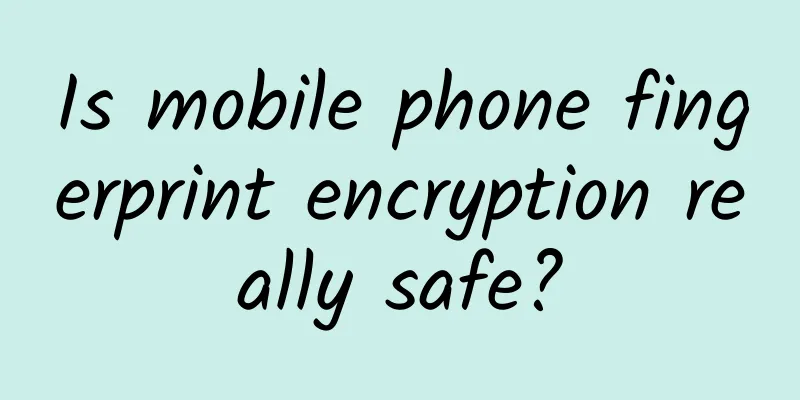Is mobile phone fingerprint encryption really safe?

|
Recently, a new selling point has emerged in the mobile phone field, which is fingerprint encryption. For example, iPhone 5S, iPhone 6, Huawei MATE 7, Meizu MX4 PRO, etc., all use fingerprint encryption as a selling point. The battle of fingerprint recognition function has upgraded from "whether to put it" to "whether to put it on the front or the back". On the one hand, this is because users are not satisfied with the basic functions that mobile phones already have. On the other hand, it is also because users' security awareness has increased. Mobile phones carry too much sensitive information, so they must have a set of sufficiently secure protection measures. Perhaps because fingerprints are unique to each person, it seems that fingerprints are more secure than passwords. But is this really the case? If you put aside the various deceptions of mobile phone manufacturers and carefully consider fingerprint recognition itself, it seems to be a different story. Our use of fingerprints has gradually become more diverse. On some mobile phones today, you only need to press your finger lightly on the fingerprint sensor, and the fingerprint will be recognized within one second, and the phone will respond to the corresponding operation, such as unlocking or paying, etc. How is this achieved? As early as the iPhone 4 era, there were fingerprint encryption applications in the Apple APP Store. Just put your finger on the screen to perform encryption, decryption and other operations, which looks like turning the touch screen into a fingerprint sensor. Most of them are deceptive, but they are not without reason. In essence, the fingerprint sensor used in mobile phones is also a capacitive screen, and the working principles of the two are almost the same. It’s just that compared to the touch screen, the resolution of the fingerprint sensor is several orders of magnitude higher, so it can recognize fingerprint features. It cannot be denied that the part between the fingerprint reader and the mobile phone system is quite safe. From hardware to software, every manufacturer has put a lot of effort in this link. There is hardware dedicated to encryption, proprietary transmission protocols, multiple protections to prevent cracking, and a powerful encryption network that closely links them together, making it so safe that it is almost impossible to crack. If the fingerprint system is compared to a lock, this is equivalent to the lock core, and this lock core is almost invincible. However, if you copy the key... This is the crux of the matter. Although fingerprints are unique, they are too common in our living environment. Whether it is work, life, or entertainment, we cannot leave our hands at home or hide them when we do anything. Hands come into contact with various things, so the chemicals secreted by the skin of the fingers leave fingerprints in various environments. As early as 1892, the police had learned to identify criminal suspects by fingerprints, and these fingerprints must be those that the parties did not want to leave. Fingerprints can be used for detection because there is a correspondence between a specific fingerprint and a specific person. Unfortunately, this correspondence is not equal, that is, a person can be locked by a fingerprint, but the reverse is not true, that is, a person in a certain situation may not leave his fingerprint. Because whether you like it or not, you are spreading your fingerprint information everywhere, allowing others to steal and forge your fingerprints. The problem with this method of regenerating a three-dimensional fingerprint from a flat fingerprint is that it is too expensive, so the content in the phone must be very valuable to be worth trying. However, in the process of anti-theft, the fingerprint sensor has become a pig teammate in reducing costs. How can we easily obtain the correct fingerprint information? Let's take a look at an example. The following picture is a review of the Meizu MX4 PRO phone on a well-known domestic IT website: If you can't see the main point clearly, the enthusiastic editor has also provided high-resolution original images in the gallery: It seems that there is no need for further nonsense. Next, you need a little toner and a piece of transparent tape... This is a typical case of a key forgotten in a lock. Fingerprint recognition is a thing where the user protects himself with a seemingly "unique" lock, while throwing the "key" that can unlock the lock around, thinking that the thief will not find it. In fact, the thief thinks it is not worth it. So the question is, why is fingerprint so popular even though it can be cracked? Because fingerprint is the most convenient encryption method. Mobile phones without encryption are the most convenient but insecure, while mobile phones with passwords are secure but the least convenient. Fingerprints are right in between the two, finding a balance between convenience and security that is easy for users to accept. In mobile phone products, even if there is a chance to crack fingerprints, there is no guarantee that the investment in stealing secrets is equal to the benefits. Fingerprint recognition increases the cost and risk of stealing secrets. In other words, fingerprint recognition is to drive away secret thieves by raising costs, rather than security. However, with the rise of various mobile payments, fingerprint recognition is no longer just used to protect important information, but will also be directly closely related to personal property. So is fingerprint recognition still safe? As long as it is worth it, someone will definitely crack it. It is not difficult to imagine that after the rise of new application methods such as mobile payments, fingerprint collection and cracking will definitely form an industrial chain. So if you really believe that fingerprints are safer than passwords, you may suffer heavy losses. As a winner of Toutiao's Qingyun Plan and Baijiahao's Bai+ Plan, the 2019 Baidu Digital Author of the Year, the Baijiahao's Most Popular Author in the Technology Field, the 2019 Sogou Technology and Culture Author, and the 2021 Baijiahao Quarterly Influential Creator, he has won many awards, including the 2013 Sohu Best Industry Media Person, the 2015 China New Media Entrepreneurship Competition Beijing Third Place, the 2015 Guangmang Experience Award, the 2015 China New Media Entrepreneurship Competition Finals Third Place, and the 2018 Baidu Dynamic Annual Powerful Celebrity. |
>>: Lessons from China’s 4G breakthrough
Recommend
How much does it cost to invest in the Fuzhou Course Mini Program?
How much does it cost to attract investors for th...
Worse than staying up late! How harmful is “fragmented sleep”?
Review expert: Wang Xuejiang, professor at Capita...
WWDC 2016: A comprehensive upgrade of OS experience
In order to showcase the latest software and tech...
China Automobile Dealers Association: Used Car Weekly Report from November 8 to 14, 2021
1. Weekly transaction trend of used cars in Novem...
Slacking Thinking + Boss Cultivation Club · Paste and Copy to Make Money [Complete] Watch Online
I made more than 30,000 yuan by copying and pasti...
In order to "put more 'Chinese oil' in the oil bottle", she "grinded" for 10 years
Source: Xinhua Daily Telegraph report, March 7 Au...
BMW brand car sales reached 2.2 million in 2021, surpassing Mercedes for the first time since 2015
BMW beat longtime rival Mercedes-Benz to take the...
The mysteries of the universe: the movement of celestial bodies: Why are they rotating? And how do they rotate?
Absolute stillness does not exist in the universe...
[Dry stuff!] 】How to save money and improve efficiency in advertising? Data optimization "three axes"
How to extract value and potential opportunities ...
Honda joins Baidu's Apollo platform to make self-driving cars a reality
Recently, according to a report by the Nikkei, Ho...
Morgan Stanley: Research shows that Chinese companies account for 63% of the global humanoid robot industry chain
Morgan Stanley recently released "Humanoid R...
Copywriting skills: 16 common UI copywriting mistakes
There are many techniques in copywriting design, ...
Technical tips! "Ya Ya", "Meng Lan", "Hua Hua"... How to distinguish who is who among so many pandas?
After about 16 hours of flight, the cargo plane c...
Postpartum care center-Tencent advertising customer acquisition strategy
Industry dynamics overview The market size has a ...
Look! China's most magnificent animal wonders
This is the most magnificent animal wonder in nat...









